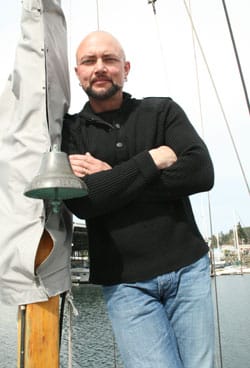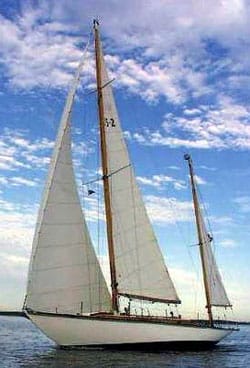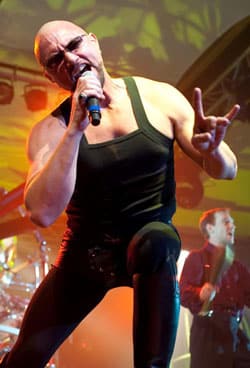
Geoff Tate
Queensrÿche. Surely you’ve heard of this successful progressive metal band. They took off in the 1980s, when hair bands tossed their manes and headbanging power ballads and Mötley Crüe’s double umlauts made headlines (watch Queensrÿche on stage here).
Geoff Tate is Queensrÿche’s songwriter and lead singer, and his music and band career span three decades.
Geoff and his cohorts formed the band, first called The Mob, in Bellevue, Washington, in 1981, and today, Queensrÿche has sold 20 million albums worldwide while its members have pulled off a grinding tour schedule that’s had them play dates in 36 countries.
Life’s often “a bit hectic,” Geoff says. In the meantime, he and his wife, Susan, have raised four daughters. When not making music or handling family matters, Geoff has a couple of hobbies, including promoting his own line of fine wines.
The other pastime helps him recharge his psychic batteries and find a quiet space in which to create new artistic material. When not rocking hard on stage, Geoff rocks gently in a lonely bay on board his classic wooden yawl, the John Alden-designed Malabar XV.
I met up with Geoff in Kingston Marina, on the Kitsap Peninsula across Puget Sound from Seattle, Washington, to learn more about him and his apparently incongruous connection to this historic old Alden.

Growing up in a military family in the Pacific Northwest, Geoff was no stranger to mobility, but Tacoma, Washington, was the closest thing he had to a hometown. His first memory of sailing was with his grandfather in a little V-bottom wooden sloop. He says he did a lot of growing up on that boat.
He spent a good deal of his youth beachcombing on the Tacoma waterfront. One day, he and his cousin came across a small rowboat grounded on the beach. They posted a lost-and-found ad in front of the local grocery store, but when no one responded, they assumed their first command. They patched it up, painted it, and made a mast and, with their grandmother’s donation of a bedsheet, a sail. For years they explored the many nooks and crannies of Puget Sound in that humble little craft.
He learned to love sailing, but as he grew into adulthood, he found a second calling. Music was her name. The Pacific Northwest has always been a hotbed of innovate popular music. The list of native sons and daughters who’ve made it big reads like the roster of a rock hall of fame: Portland’s Kingsmen, The Wailers, the Sonics, Paul Revere and the Raiders, Jimi Hendrix, Heart, Nirvana, Soundgarden, Pearl Jam, and many others.
In 1981, Geoff added to that list with the formation of Queensrÿche, which might have then been described as a hard-rocking hair band with no lack of attitude. Drawing on influences from classical, jazz, folk, and rock, they developed a sophisticated sound and original lyrics into a national and then international following. It’s been a long and wild ride for the four bandmates, but not one that’s likely to end soon—when I caught up with Geoff, the bandmembers were about to jet off to Moscow to begin yet another world tour.

Geoff carries on board his Malabar XV a mini sound studio and a high-speed Internet connection to his musical collaborators. When things get too cacophonous at home, he jumps on the boat and heads out alone to a sleepy island in Puget Sound or to the San Juan Islands. There he sequesters himself on board for days, reaching deep into his heart and mind for new expressions of music and meaning.
“There’s no atmosphere on earth as conducive to creativity as that of a classic wooden boat,” he says.
As he toured the great coastal cities of the world, Geoff spent all his free time walking their docks and marveling at their diverse nautical designs. He saw some real beauties, but the first time he walked past Malabar XV, she stopped him dead in his tracks. Those classic lines somehow spoke to him. She sat on the market unsold for two years, but in 2004, when the owner finally dropped his price, Geoff swooped in.
After the fact, he informed Susan. Her first reaction?
“You have got to be kidding me!”
She’s since come to love the boat, and Geoff says that she now sails it better than he can.
“In fact,” Geoff says proudly, “when the fan belt broke yesterday, she sailed it engineless into this slip.”
When I looked around the crowded marina with its narrow approaches, I realized that this was no mean feat. But even a good skipper couldn’t make up for a bad boat in here.
John Alden unquestionably ranks as one of America’s finest yacht designers. His designs were graceful and conservative, concentrating on seaworthiness, comfort, aesthetics, and maneuverability.
However, conservative or not, Alden’s designs were known not only for their seductive curves and ease of handling but also as the scourge of a starting line. In the 1923 Bermuda race, his Malabar IV won first place, and in one Bermuda race, boats named Malabar took three of the first five places.
Starting in 1921, Alden had designed and had built a series of Malabar schooners; they were named for a shoal off Cape Cod, Massachusetts, that’s now eroded away. He would own and sail each boat extensively for a year or two, then sell it off and go back to the drawing board to fine-tune his thinking. These designs ranged from 41 to 58 feet and displaced up to 61,000 pounds. He followed this pattern through to his last Malabar, now Geoff’s boat, the one then known as the XV 901-A (yawl rigged), which he had built in 1955 and sold in 1957.
There are no records regarding the vessel’s welfare and whereabouts from 1957 until approximately 1964. That’s when Geoff picked up the paper trail, which establishes that Malabar IV had numerous U.S. East Coast owners, made a transit of the Panama Canal, and had an Alaskan owner who nearly lost her to ice damage.
Thus, much like her present owner, this salty child of the 1950s shows the character lines of a life fully lived. There’s no denying that the boat needs some tender loving care, but Geoff’s busy work schedule presently precludes a full refit.
For now, he’s happy just to enjoy this historic craft as is and effect one or two notable upgrades per season. But with time and care, he hopes to restore her to her original glistening glory.
“This is the finest boat that I’ve ever sailed,” Geoff says.
He finds her performance, especially in light airs, so surprisingly stellar that he hopes one day, in his elusive spare time, to organize a regatta series for classic wooden boats in Seattle in which to campaign her yet again.
I suspect that they’ll make beautiful music together.
After countless bluewater miles, CW contributing editor Alvah Simon is back home in New Zealand preparing the 36-foot steel cutter Roger Henry for a refit.







